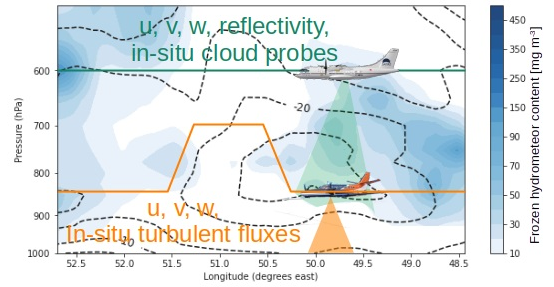NAWDIC-DICHOTOMI
The project DICHOTOMI (Dry Intrusion and Cloud Head winds On Top Of Marine Interfaces) aims at better understanding the formation of damaging surface winds in extratropical cyclones, in particular near the dry intrusions and the cloud head regions. Several factors can influence the formation of damaging surface winds, like the static stability, the wind shear, the surface heat fluxes, the evaporative cooling of precipitating clouds or the surface roughness associated with sea state conditions. Even though all these ingredients are well known to be important, their relative roles in downward momentum transport needs to be clarified.
The project, which is funded by the French and German Research Foundations (ANR and DFG), is part of an international effort under the framework of NAWDIC and includes the deployment of two aircraft and two ground-based observing systems. The French ATR42 aircraft and the German Cessna F406 research aircraft will be deployed from Shannon (Ireland) and Brest (France), and are equipped with state-of-the-art remote-sensing and in-situ instruments (Fig. 1). The two ground-based observational platforms will be deployed along the French and Irish coasts and composed of networks of Doppler wind lidars, water vapor lidars and Doppler cloud radars. Important synergies exist between the two aircraft and the ground-based observations to get a unique set of complementary measurements of fine-scale wind structures, clouds and surface characteristics.
A hierarchy of Limited Area Models will be run for selected case studies in different configurations including convection-parameterized models (CPM, horizontal grid spacing ~10 km), storm-resolving models (SRM, horizontal grid spacing ~1 km) and large-eddy simulations (LES, horizontal grid spacing ~100 m). Parameterizations of cloud microphysics, shallow convection, turbulence together with diagnostics of wind gusts will be tested in CPM and SRM simulations by confronting them to observations. LES simulations resolve shallow convection and the most energetic turbulent eddies and serve as reference for SRM, where these processes are parameterized, but the realism of simulated convective rolls in LES setup will be assessed by comparing them with fine-scale observed wind features. In addition to improving our knowledge of the underlying processes responsible for the formation of damaging winds, such a project will provide guidance in the development of future parameterizations of cloud microphysics, shallow convection and air-sea flux exchanges.
Contact: Gwendal Rivière (LMD), Julian Quinting (KIT)

